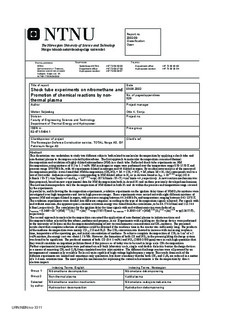| dc.description.abstract | This dissertation was undertaken to study two different subjects both related to molecular decomposition by applying a shock tube and non-thermal plasma to decompose selected hydrocarbons. The first approach to molecular decomposition concerned thermal decomposition and oxidation of highly diluted nitromethane (NM) in a shock tube. Reflected shock tube experiments on NM decomposition, using mixtures of 0.2 to 1.5 vol% NM in nitrogen or argon were performed over the temperature range 850-1550 K and pressure range 190-900 kPa, with 46 experiments diluted in nitrogen and 44 diluted in argon. By residual error analysis of the measured decomposition profiles it was found that NM decomposition (CH3NO2 + M -> CH3 + NO2 + M, where M = N2 /Ar) corresponds well to a law of first order. Arrhenius expressions corresponding to NM diluted either in N2 or in Ar were found as kN2 = 1017.011×exp(-182.6 kJ/mole / R×T and kAr = 1017.574×exp(-207 kJ/mole / R×T ), respectively. A new reaction mechanism was then proposed, based on new experimental data for NM decomposition both in Ar and N2 and on three previously developed mechanisms. The new mechanism predicts well the decomposition of NM diluted in both N2 and Ar within the pressure and temperature range covered by the experiments.
In parallel to, and following the decomposition experiments, oxidative experiments on the ignition delay times of NM/O2/Ar mixtures were investigated over high temperature and low to high pressure ranges. These experiments were carried out with eight different mixtures of gaseous NM and oxygen diluted in argon, with pressures ranging between 44.3-600 kPa, and temperatures ranging between 842-1378 K.
The oxidation experiments were divided into different categories according to the type of decomposition signals achieved. For signals with and without emission, the apparent quasi-constant activation energy was found from the correlations, to be 64.574 kJ/mol and 113.544 kJ/mol, respectively. The correlations for the ignition delay for time signals with and without emission were deduced as τemission = 0.3669×10-2×[NM]-1.02[O2]-1.08×[Ar]1.42×exp(7767/T) and τno emission = 0.3005×10-2×[NM]-0.28[O2]0.12×[Ar]-0.59×exp(13657/T), respectively.
The second approach to molecular decomposition concerned the application of non-thermal plasma to initiate reactions and decompose/oxidize selected hydrocarbons, methane and propane, in air. Experiments with a gliding arc discharge device were performed at the university of Orléans on the decomposition/reforming of low-to stoichiometric concentration air/CH4 mixtures. The presented results show that complete reduction of methane could be obtained if the residence time in the reactor was sufficiently long. The products of the methane decomposition were mainly CO2, CO and H2O. The CH4 conversion rate showed to increase with increasing residence time, temperature of the operating gas, and initial concentration of methane. To achieve complete decomposition of CH4 in 1 m3 of a 2 vol% mixture, the energy cost was about 1.5 kWh. However, the formation of both CO and NOx in the present gliding discharge system was found to be significant. The produced amount of both CO (0.4-1 vol%) and NOx (2000-3500 ppm) were in such high quantities that they would constitute an important pollution threat if this process as of today was to be used in large scale CH4 decomposition. Further experimental investigations were performed on self-built laboratory scale, single- and double dielectric-barrier discharge devices as a means of removing CH4 and C3H8 from simulated reactive inlet mixtures. The different discharge reactors were all powered by an arrangement of commercially available Tesla coil units capable of high-voltage high-frequency output. The results from each of the different experiments are limited and sometimes only qualitative, but show a tendency that the both CH4 and C3H8 are reduced in a matter of a 3-6 min. retention time. The most plausible mechanism for explaining the current achievements is the decomposition by direct electron impact. | nb_NO |
